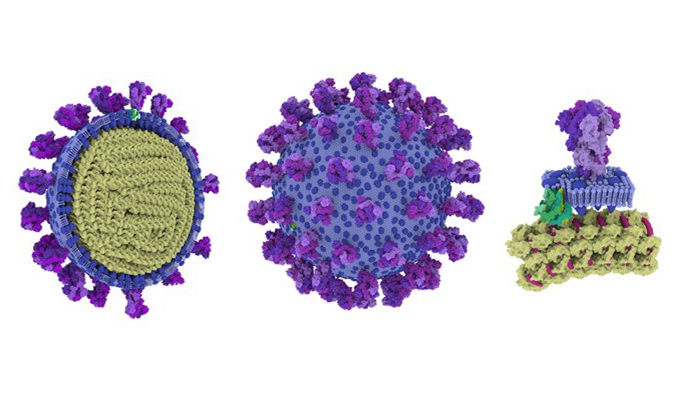COVID-19 virus made visible
Published: 4 June 2020
Scientists at the Institute of Infection, Immunity and Inflammation Centre for Virus Research have collaborated with illustrator Annabel Slater on a detailed model of the SARS-CoV-2 particle

Scientists at the Institute of Infection, Immunity and Inflammation Centre for Virus Research have collaborated with illustrator Annabel Slater on a detailed model of SARS-CoV-2 particle.
As the world races to understand the virus responsible for the COVID-19 pandemic, scientists are gaining increasing amounts of information about the components that make up the infectious particles.
While each new discovery provides scientists and governments with vital new information on SARS-CoV-2, none are able to give a clear overall image of the invisible agent behind the current pandemic.
Now, a collaboration has created one of the most detailed 3D models of both the interior and the exterior of the virus particle.
Using methods developed by experts from the School of Simulation and Visualisation (SimVis) at the Glasgow School of Art, Annabel Slater, a freelance scientific Illustrator and graduate of The GSA–University of Glasgow Masters in Medical Visualisation and Human Anatomy, and scientists at the CVR have produced striking representations.
Piecing together the complex scientific jigsaw of all the known details about this new coronavirus so far, the cross-disciplinary team created a series of images and videos.
While the detailed illustrations do not reveal any new information about SARS-CoV-2, the virus responsible for the COVID-19 pandemic,they are one of the first and most detailed 3D representations of the virus particles.
These have been made freely available to view online and to download on the UK Research and Innovation (UKRI) COVID-19 website, Coronavirus Explained, for use by anyone who wishes to visualise SARS-CoV-2.
A set of science communication resources, including colouring sheets and an augmented reality educational app, are in development at the CVR and will be released in the near future.
Annabel Slater said: “I think making scientific images into something 3D, opens up a whole new world of interaction, exploration and understanding.
"The science of a virus can be better understood by making the virus particle into something tangible and interactable.
"I hope these models of the SARS-CoV-2 virus particle will help people by making the invisible visible.”
Dr Ed Hutchinson, research fellow at the CVR who led the virology work in this project, said: “No single experiment can directly produce a detailed image of a SARS-CoV-2 virus particle.
"Not only are they incredibly small, like all viruses, but they are also irregular – every virus particle is slightly different from the next – and getting detailed information requires each component of the virus to be studied in isolation.
“Fortunately, for several years we’ve worked with students doing projects for the MSc in Medical Visualisation and Human Anatomy, including Naina Nair who developed one of the most detailed models of the influenza virus particles, which are also very irregular, and then found ways to use those models for science communication.
“When the current pandemic began, Annabel got in touch and asked if we could collaborate on a model of the SARS-CoV-2 virus particle.
"As a graduate of the MSc programme herself, she was able to quickly pick up the methods needed to build a model of the virus, working with us to interpret a set of data that combined the most up-to-date studies of SARS-CoV-2 with ‘missing information’ from studies of related viruses.”
Enquiries: ali.howard@glasgow.ac.uk or elizabeth.mcmeekin@glasgow.ac.uk / 0141 330 6557 or 0141 330 4831
First published: 4 June 2020

